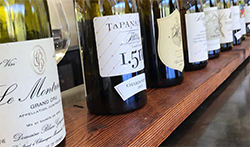2014 wine wrap: 5 things I’d like to see less of in 2015
At this time of year everyone seems to have a ‘best of’ list, preferably pointing out the best (or even the worst) from the year all wrapped up in an easy-to-read package.
So I’m going to do the same. Just different.
Stu (the Vinsomniac) has already highlighted a few poignant events in his year of Australian wine. Halliday has his Top 100, and everyone has a wine and winery of the year, so not bothering with that stuff either (though I did a winery last year).
But this year, I’m doing something different – I’m channeling my grumpiness to highlight five (wine) things I’d like to see less of in 2015. Maybe a little ranting, but hopefully you get the drift.
Thanks, also, to you for reading this and I hope 2015 is your best year ever. I’m hoping its mine too…
So, I’d like to see less:
1. Aneamic Australian Chardonnay
If I see the words ‘Chablis style’ on a winery tasting note (and the wine is not from Chablis) I’m immediately suspicious. Simply put, the quest for ‘minerality’ and ‘freshness’ in Australian Chardonnay has gone too far, resulting in too many wines that taste more like Semillon (or Sauvignon Blanc than Chardonnay. Winemakers: malolactic fermentations are not evil. As Brian Croser once said to me ‘Chardonnay needs to go through malo’. Brian said that with caveats (Hunter Chardonnay doesn’t need it for example. Chablis either), but on the whole, malo has a purpose. Ditto the judicious use of oak, solids and wild yeast ferments. All of these things – in moderation – are what makes the best Chardonnay the best Chardonnay. Oh and early picking is ok if you want to make sparkling wine, but if the grapes aren’t ripe, the wine will never be great. Ever.
2. ‘Minerality’
Jamie Goode has covered the use of ‘minerality’ in a nicely balanced, scientific fashion here, I like the notion that we can ‘taste’ minerals in wine but, as Jamie points out, the linkage between taste and actual minerals is shaky at best, which makes the usage of the term more about esoterica than anything else. Less minerality in wine writing for 2015 please.
3. Fine wine stored badly
I wrote a little piece some time ago about the perilous conditions wine is subject to in duty-free shops. I’d like to revise that complaint to incorporate all the bottleshops that persist in putting their best bottles in brightly lit, completely exposed (warm) cabinets. What’s more, even respected fine wine retailers are guilty of this. Memo wine merchants – wine needs darkness and cool temperatures. No excuses.
4. Australian full bodied reds without (natural) tannins
I’m picking on Australia here as this is Australian Wine Review, but many new world (and indeed many newer old world) producers are guilty of this. The problem is that ‘bitterness’ (which comes from flavonoids and alcohol) is perceived as a negative in commercial wine, which means that all steps are used to avoid anything that can produce it. As a result reds are fermented warm and pressed gently off skins before ferment is complete (which aids colour but limits extraction of the tannins or other other flavonoids, while also leaving some residual sugar for sweetness), before then being fined to remove anything left (which may remove more tannins). Such winemaking ultimately produces soft, generous reds with loads of fruit flavour but little in the way of structure (unless they’re propped up with added tannin, which is problematic). Combine that with plenty of added acid and you’ve got fruity, tart wines that tend to look both fat and unbalanced after a few years in the bottle. Such winemaking is definitely on the old school side of the fence, yet still new producers keep making wines like this as they also win show medals (because that rich juiciness looks mighty flattering in a line up) which doesn’t help progressing the style either. Again, more time on skins, less residual sugar, less heavy fining and more real tannins would make me very happy. It’s a long shot though.
5. Hate for cloudy and orange wines
This year we had #orangegate, which was plain ridiculous (and even some Orange producers have confided that they were embarrassed by the brouhaha). But on the topic, I think we place way too much emphasis on colour and ‘brightness’ in wine, largely because we are still beholden to a technical winemaking philosophy that dictates all wines must be bright and not cloudy (or orange for that matter). Indeed the twenty point wine scoring system developed at Davis in ’59 gives 20% of the points to colour and appearance, because historically wines that weren’t bright, had some brownness or cloudiness were considered faulty. Fast forward to 2015 and this emphasis is overdone, leading to a whole generation of wines that are ultra clean, ultra bright and ultra lacking in flavour (particularly in white wines). More judicious fining and filtration, for starters, would help give many wines a welcome kick of complexity without losing much ‘cleanliness’. As for orange, cloudy or weird coloured wines? If they taste good, then bring them on. To dismiss on the basis of colour and clarity is pure folly.
Help keep this site paywall free – donate here






3 Comments
Thanks for the mention AG.
Love your 5 (with the exception of #2 :). It just breaks my heart to walk into a bottlo (I use that term to cover anywhere that sells wine off-premise) and see wines stored in bright light (natural or electric) and also to see wines under cork upright on a shelf (often under separate shelf light too. Love your product people. Treat it like any other perishable good.
Maddening isn't it!
Happy new year mate
I'm certainly no afficionado, but amen to #1. Spread the word. It's been frustrating and disheartening to see shelves lined with Australian Chardonnay but very few which deliver body and oak and buttery depth. There's enough other acidic/fruity/fresh whites to go around without adding Chardonnay to that catergory too!